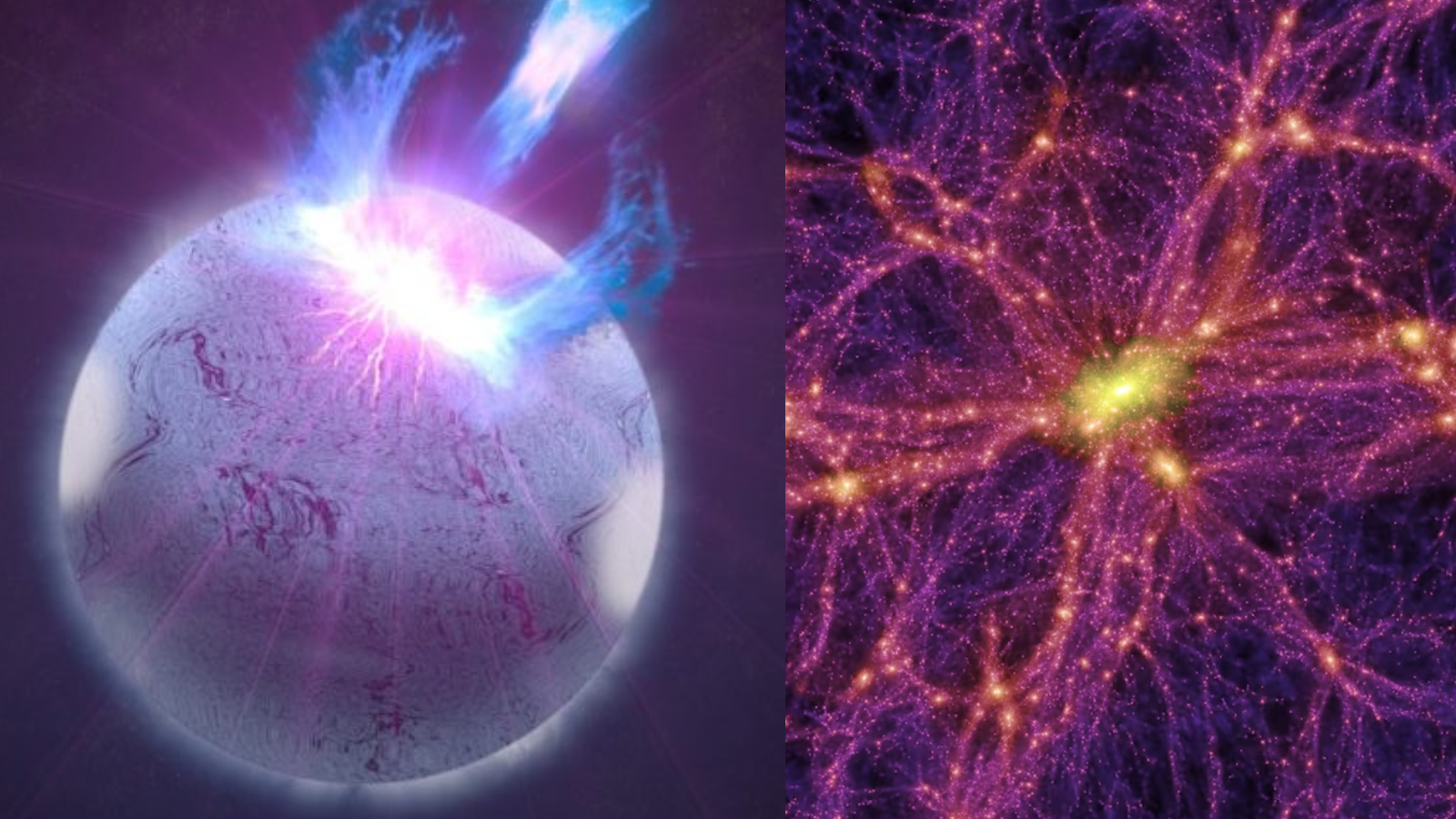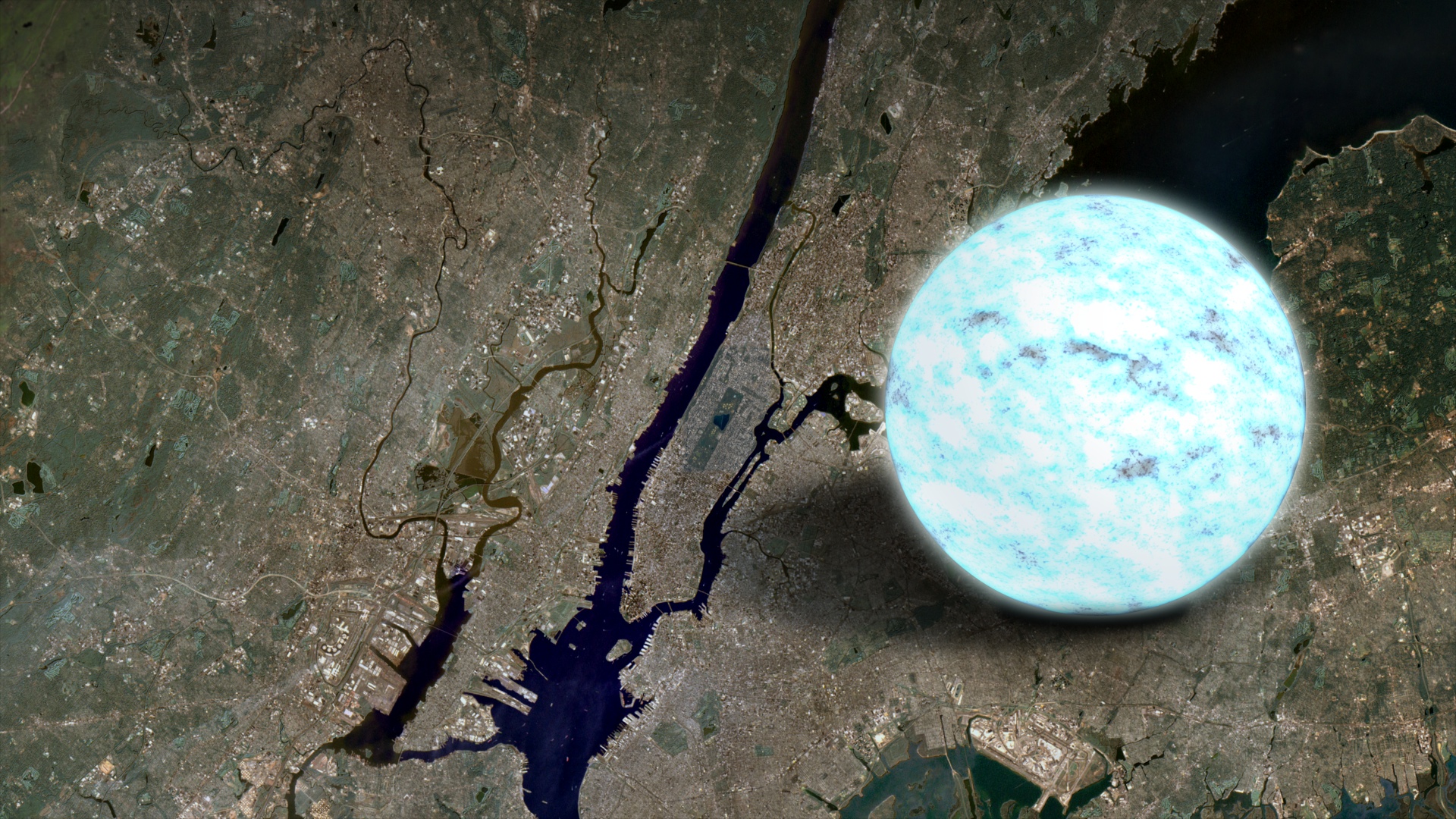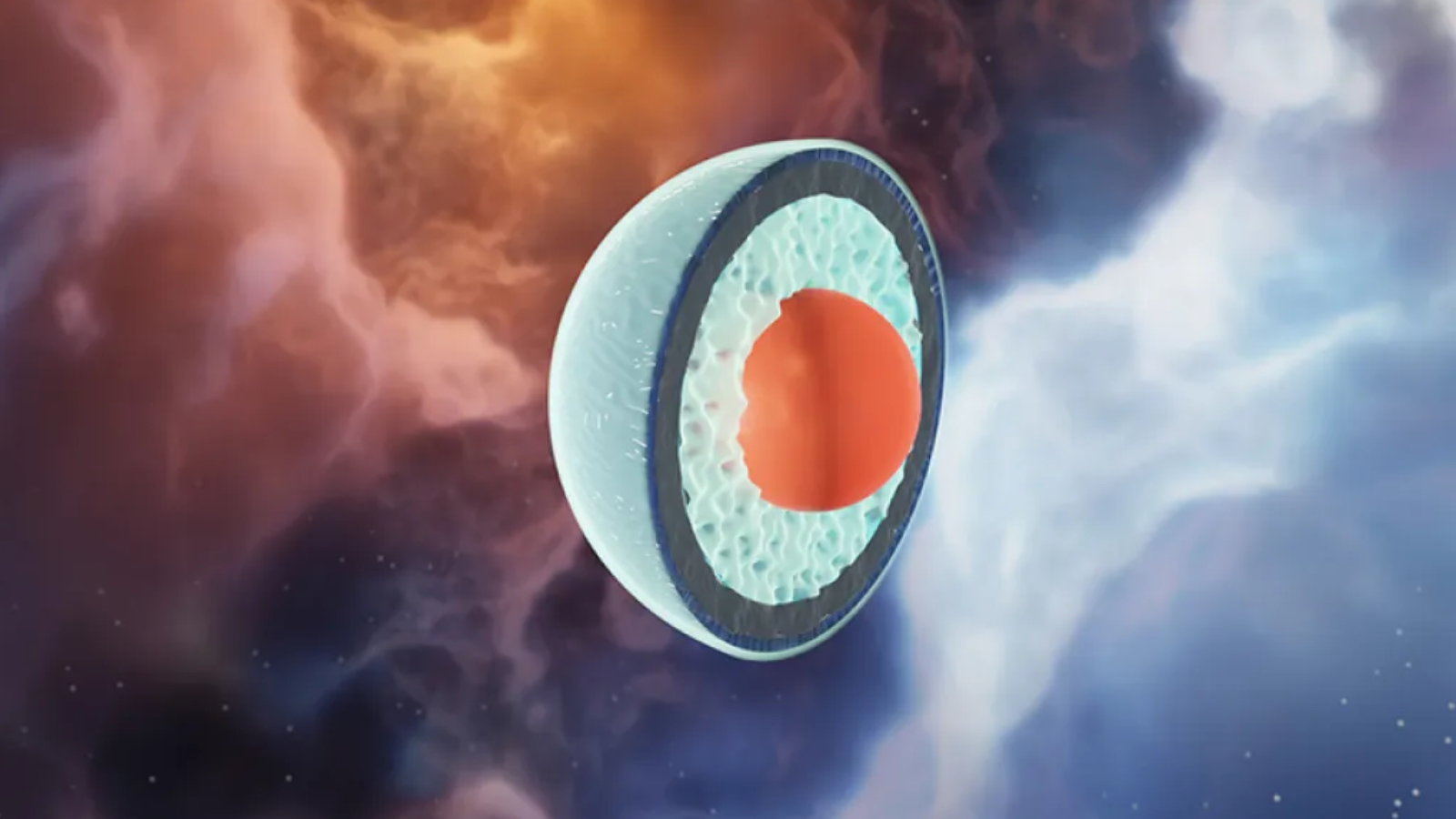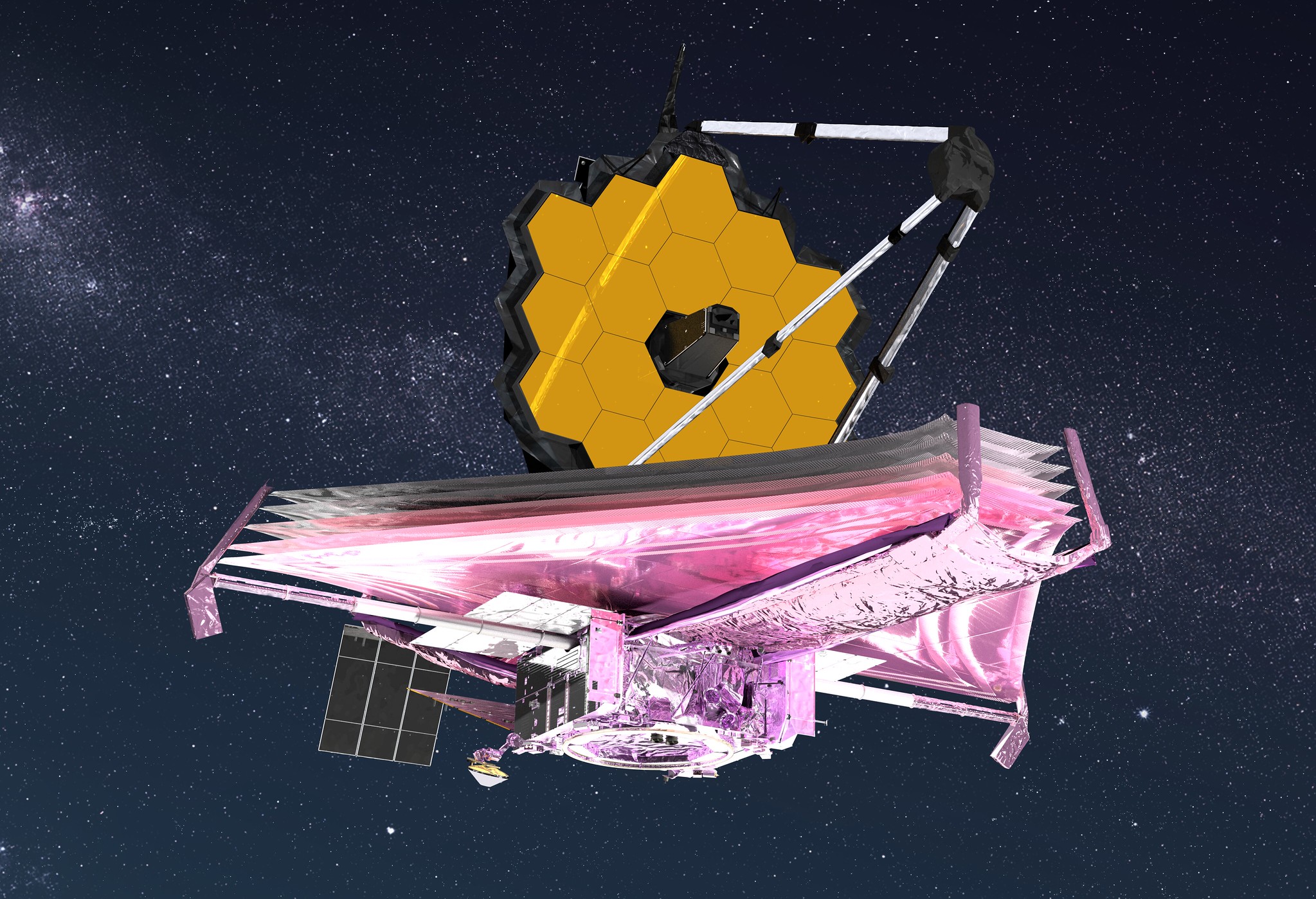Across the universe, dark matter annihilation could be warming up dead stars
"The capture and annihilation of dark matter in neutron stars would provide a source of heating that stops the star from getting really cold."

Scientists posit that some dead stars made from the densest material in the known universe, so-called "neutron stars," could act as traps for dark matter particles that smash together at high speeds and annihilate one another. In turn, the crew says, the annihilation process likely heats the dead stars from the inside out.
In general, dark matter is a problematic subject for researchers because, despite making up an estimated 85% of the stuff in the universe, it is effectively invisible because it doesn't interact with light. Dark matter also doesn't seem to interact with "ordinary matter" made up of protons, neutrons and electrons, either — or, if it does, these interactions are rare and weak. We've never seen them. This brings up an interesting question: Does dark matter interact with itself?
Nicole Bell, a theoretical physicist at the University of Melbourne, is interested in the kind of dark matter self-interaction that occurs in normal matter when an electron and its anti-particle, a positron, meet and annihilate, thereby releasing energy. Dark matter is electrically neutral, which means that whatever particles make up the substance could theoretically have their own antiparticles, too.
And, like with normal matter annihilation, when dark matter particles meet, dark matter annihilation should happen — and neutron stars could be the ideal extreme environment for such interactions.
Related: Exotic 'Einstein ring' suggests that mysterious dark matter interacts with itself
"Annihilation is when a particle and antiparticle collide and destroy each other. This is what would happen if dark matter is its own antiparticle, as is often assumed in the most widely studied dark matter models,'" Bell told Space.com. "The capture and annihilation of dark matter in neutron stars would provide a source of heating that stops the star from getting really cold."
That means that if neutron stars can act as "dark matter traps," then they could emit a thermal signature. If this can be detected, neutron stars could act as rudimentary "dark matter detectors," which would help scientists hunt down this effectively invisible form of matter.
Get the Space.com Newsletter
Breaking space news, the latest updates on rocket launches, skywatching events and more!
What it takes to ensnare dark matter
A neutron star is born when a star at least eight times as massive as the sun runs out of the fuel supply it needs for nuclear fusion occurring in its core. This ends the outward force driven by radiation pressure that has supported the star against the inward force of its own gravity for millions, or sometimes billions, of years.
As a result, the core of the star collapses, sending out shockwaves that trigger a supernova. This shockwave blows away the dying star's outer layers as well as the majority of its mass, leaving behind a stellar core with a mass between one and two times that of the sun that has collapsed to a width of around 12 miles (20 kilometers).

Crushing a mass equivalent to over half a million Earths into a body that could sit within the city limits of Chicago naturally has an extreme effect on the matter of that stellar core. It forces electrons and protons together, creating a sea of neutrons, which are particles only normally found at the hearts of atoms. This sea of neutrons that makes up a neutron star is so dense that if a mere tablespoon of it were brought to Earth, it would weigh over 1 billion tons. That's about the same weight as Mount Everest.
Neutron stars are thus made of the densest matter in the known universe, and that's why scientists believe their gravitational influences could be great enough to ensnare dark matter — which, despite its lack of interaction with light and matter, does interact with gravity.
Bell explains that dark matter annihilation is thought to have happened frequently when the 13.8 billion-year-old universe was less than a second old, but is thought to rarely happen in the present-day universe. The one exception to this would be in regions in which there is a lot of dark matter.
And if dark matter can indeed accumulate in the interiors of neutron stars, Bell and colleagues found this would provide precisely that dark matter-rich environment, thus allowing it to annihilate in the aged universe.
"You could end up with a lot of dark matter in a small area, enough that there could be an appreciable amount of dark matter annihilation happening in these stars," Bell said.
Bell added that, in dark matter experiments in laboratories on Earth, scientists search for signals of dark matter particles interacting with ordinary matter, but neutron stars have a natural advantage in this respect.
"In the lab, we are looking for collisions between dark matter particles and atomic nuclei," she said. "But if that can occur, then dark matter must also be able to collide with the neutrons and protons in neutron stars. And neutron stars have a lot of neutrons."
In addition to this, Bell was surprised to learn, as she investigated neutron stars and dark matter, that the immense gravity of neutron stars could create another condition that makes the self-interaction of dark matter particles even more likely within these dead stars.
"Dark matter is accelerated to speeds close to the speed of light when it infalls to a neutron star," Bell said. "This is useful because it can enhance the rate of interactions, potentially allowing us to probe some types of dark matter interactions that would be almost impossible to see in experiments on Earth."

Dark matter annihilation releases thermal energy into these dead star traps, so the team also looked at how long it would take neutron stars and the dark matter they capture to reach a state called "thermal equilibrium." This is the point at which two substances reach the same temperature, and heat no longer flows between them.
This investigation revealed that a dark-matter-saturated neutron star could reach thermal equilibrium in a period no longer than 10,000 years, and as short as one year, depending on the model used. In cosmic terms, this is a mere blink of an eye.

To validate this theory, researchers would need to measure the temperature of neutron stars. Finding these extreme dead stars are hotter than expected would reveal dark matter particles are indeed annihilating in their interiors. Such a discovery would be no mean feat, however, as only older and colder neutron stars would emit thermal radiation that is not overwhelmed by other light. This would require the most powerful observational instrument humanity has ever shot into space: The James Webb Space Telescope.
"The neutron stars we are most interested in are very cold stars, which are difficult to see," Bell added. "The temperatures of these stars would lead to emission in the near-infrared, which may be possible to see with the James Webb Space Telescope (JWST)."
The lack of understanding regarding neutron stars could mean that this model of dark annihilation might be easier to test with the type of stellar remnant left behind when more diminutive stars like the sun die: White dwarfs.
"Neutron stars would be good for capturing dark matter because of their extreme density. But they are also relatively poorly understood stars," Bell concluded. "Similar ideas can be applied to other stars that we understand better, such as white dwarf stars."
If the theory turns out to be correct, it would not only shine a light on dark matter but also help scientists better understand the evolution of neutron stars.
Bell and colleagues' research, yet to be peer-reviewed, is available on the paper repository site arXiv.
Join our Space Forums to keep talking space on the latest missions, night sky and more! And if you have a news tip, correction or comment, let us know at: community@space.com.

Robert Lea is a science journalist in the U.K. whose articles have been published in Physics World, New Scientist, Astronomy Magazine, All About Space, Newsweek and ZME Science. He also writes about science communication for Elsevier and the European Journal of Physics. Rob holds a bachelor of science degree in physics and astronomy from the U.K.’s Open University. Follow him on Twitter @sciencef1rst.
-
Unclear Engineer There certainly is a lot of speculation in this hypothesis.Reply
But, why would dark matter annihilation necessarily produce heat in regular matter?
Why would dark matter self-annihilation produce regular photons instead of "dark photons" that do not interact with regular matter? If they produce "dark photons"that do not interact with regular matter, then they would not heat the regular matter - they would just pass through.
This is another one of those speculations where "dark something" does exactly what the theorist wants, and not what the theorist does not want. Handy, but not convincing.
I could just as easily speculate that dark matter annihilation is the driving mechanism for dark energy, and probably get a media story out of that.
Still, it is probably good to be able to look for unexpected things in places like neutron stars. We might find something enlightening even if it is not what we are looking for. -
Atlan0001 The dark matter universe and the anti-matter universe may be the same negative. Now how could that be if galaxies, and things like us, aren't being annihilated on a regular basis?! It might be because we hardly get any effect from such particles as neutrinos. Or a universe on the other side of the mirror zero (the grand total of matter and energy equals zero), and a universe on this side of the mirror zero, perfectly balancing in horizon, in mirror zero, simply don't do much interacting, if any interacting, unless there are special circumstances, specialized physics, involved, to cause interaction . . . an always very temporary, very localized, unbalancing (a radicalized exception to the rule).Reply -
Victor N Dlamini Reply
The dark matter could be an existence niche: a gaba domain frame of reference in systemic parallax within and gaba parallax with respect to matter. It may not interact with matter due to its different time-sweep and apparition fringes; among other gaba parallax forming dimension punctuations.Admin said:Neutron stars could act as gravitational traps for dark matter, forcing these mysterious particles to collide, annihilate and warm up otherwise cold dead stars.
Across the universe, dark matter annihilation could be warming up dead stars : Read more -
DrRaviSharma Initial transformation from DM to Matter-Energy would interact with all namely Electro-weak, Strong (cause of Neutron stars in this example), gravitation, and Electromagnetic (Photons) and it is not clear why it would be preferential with respect to neutron stars except these being massive gravitational body that warps local spacetime fabric.Reply
Thanks.
Ravi
(Dr. Ravi Sharma, Ph.D. USA)
NASA Apollo Achievement Award
ISRO Distinguished Service Awards
Former MTS NASA HQ MSEB Apollo
Former Scientific Secretary ISRO HQ
Ontolog Board of Trustees
Particle and Space Physics
Senior Enterprise Architect
SAE Fuel Cell Tech Committee voting member for 20 years.
http://www.linkedin.com/in/drravisharma -
Unclear Engineer Stating what "dark matter" would do or how it's "annihilation products" would interact with any known force should not be stated as fact, because it is all very speculative. There are no known "facts" about how dark matter behaves beyond its assumed existence to explain gravitational force observations that we cannot otherwise explain.Reply -
DrRaviSharma Yes Unclear Engineer,Reply
My article to be yet published starting in 2023 Winter and hopefully Spring or Summer 2024 issues of a Journal, that will clarify many issues surrounding DM and I will send readers a link when both parts are available.
After review you will kindly agree or disagree with that description and it will relate to our current BSM LHC and astrophysics based efforts that many have described in these threads as constituents of physical universe ranging from 5% to 15%+ of total mass needed.
Till then you are right that many do not believe in existence of DM.
Ravi
(Dr. Ravi Sharma, Ph.D. USA)
NASA Apollo Achievement Award
ISRO Distinguished Service Awards
Former MTS NASA HQ MSEB Apollo
Former Scientific Secretary ISRO HQ
Ontolog Board of Trustees
Particle and Space Physics
Senior Enterprise Architect
SAE Fuel Cell Tech Committee voting member for 20 years.
http://www.linkedin.com/in/drravisharma -
Unclear Engineer Even if you "believe" that dark matter exists, there is no direct evidence of how it interacts with other matter, or itself, other than the gravitational observations.Reply
All I am saying is that speculation should not be posted as fact. -
DrRaviSharma Yes I agree it is about semantics "as until" explained, based on readers current knowledge. And what I am adding is that the whole process of how DM interacts with forces mentioned above will become clear after the publication and then you still can either accept the fact or deny it!Reply
The reason I can not spell out all is then the journal will not most likely publish if it knows that this is already published information, hence please hold on your opinion and all I can also do is wait.
Regards,
Ravi
(Dr. Ravi Sharma, Ph.D. USA)
NASA Apollo Achievement Award
ISRO Distinguished Service Awards
Former MTS NASA HQ MSEB Apollo
Former Scientific Secretary ISRO HQ
Ontolog Board of Trustees
Particle and Space Physics
Senior Enterprise Architect
SAE Fuel Cell Tech Committee voting member for 20 years.
http://www.linkedin.com/in/drravisharma -
Torbjorn Larsson It is an interesting result, that tidal interaction with normal matter should be able to capture and thermalize dark matter so prodigiously.Reply
The self annihilation requirement is having a modicum of “Majorana” particle character mixed in with the normal “Dirac” particle character. The mix results in the particle being its own antiparticle at some decay time set by the mix ratio (among other things) but needs to be observed. Majorana properties of e.g. sterila neutrinos, a likely candidate here, has been probed in experiments but the interactions turns out to be so weak (rare) that they will likely remain dark matter candidates indefinitely. Hence the astrophysical observations may observe something like that. -
Torbjorn Larsson ReplyUnclear Engineer said:There certainly is a lot of speculation in this hypothesis.
But, why would dark matter annihilation necessarily produce heat in regular matter? Why would dark matter self-annihilation produce regular photons instead of "dark photons" that do not interact with regular matter?
Less speculative than your personal opinion of it, if you read the paper. The same goes for observed dark matter and dark energy in general, but for reasons of too many independent observations to convince scientists that these things do not exist. So why shouldn't we accept that, they are the experts after all? It is also reasonably easy to check every result they have.Unclear Engineer said:This is another one of those speculations where "dark something" does exactly what the theorist wants, and not what the theorist does not want. Handy, but not convincing.
Unclear Engineer said:Stating what "dark matter" would do or how it's "annihilation products" would interact with any known force should not be stated as fact, because it is all very speculative. There are no known "facts" about how dark matter behaves beyond its assumed existence to explain gravitational force observations that we cannot otherwise explain.
We do know it is particles so the interactions are possible and can therefore be published in peer review and later researched. We also know it interacts with gravity which even in the case of normal matter means a finite decay time, only more so. (Normal matter Higgs stabilization is long lived, dark matter likely not so much.)Unclear Engineer said:Even if you "believe" that dark matter exists, there is no direct evidence of how it interacts with other matter, or itself, other than the gravitational observations.
All I am saying is that speculation should not be posted as fact.
You should trust the process of science, among other things it has given us the engineered web things (based on semiconductor research, for one) that we comment with here.









